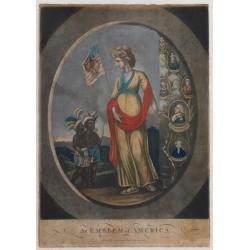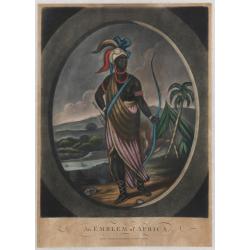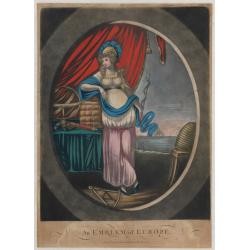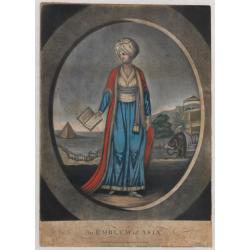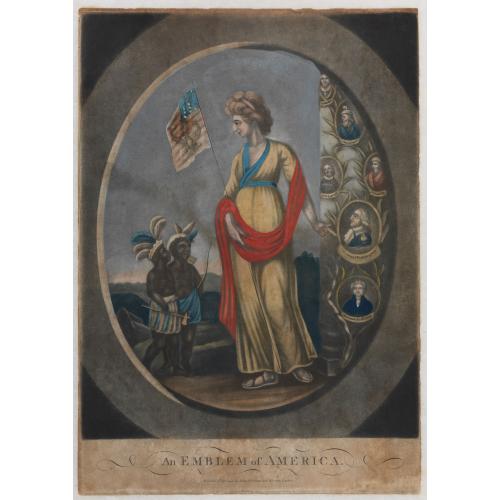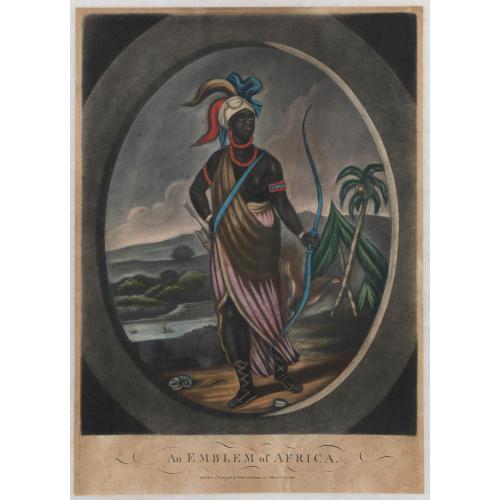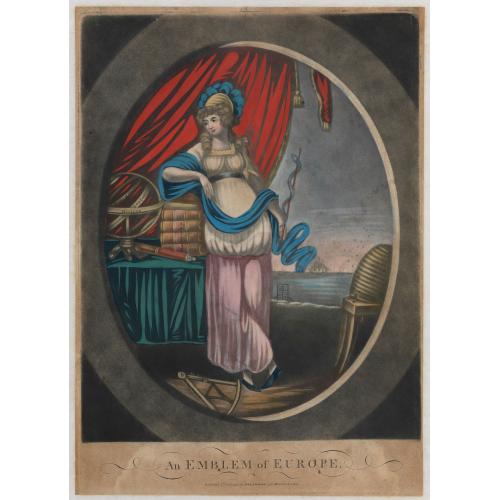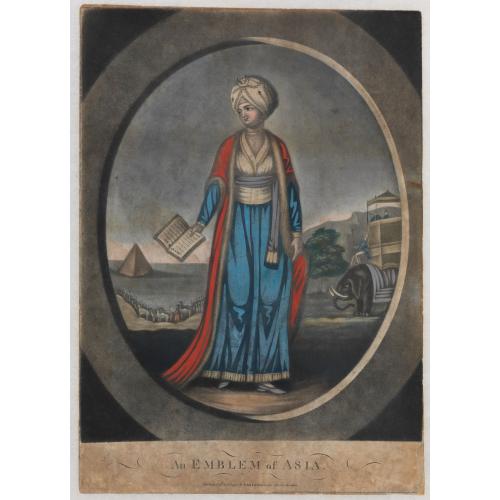Description
Shortly after the British North American colonies gained independence from England in the late-eighteenth century, the female figure of Columbia became synonymous with American identity. However, personifications of North America developed as early as the sixteenth century, with early modern artists depicting Europe, Asia, Africa, and the Americas as female figures in prints, paintings, and sculptures. Artists depicted Europe as illustrious and cultivated to glorify its greatness, whereas, artists depicted North America as unrefined and uncivilized. America(s), depicted as an "Indian Princess," often wore a feathered headdress, feathered skirt, and a bow and arrow. The figure was regularly situated within a tropical landscape, sometimes holding a parrot or sitting on an enlarged alligator or oversized armadillo, based on their own ideas of Indigenous life in North America. By the eighteenth century, as the New World became less threatening to Europe, artists and allegorists began portraying North America as the neoclassical, white, female figure that became known as Columbia.
The African American child beside Columbia, dressed in the guise of a Native American figure, may be a representation of the "noble savage" trope. A highly offensive term first appearing in seventeenth century literature, the "noble savage" referred to someone who lives in nature, uncorrupted by civilization. French philosopher Jean-Jacques Rousseau later embraced the concept to highlight the corruption of European civilization in much of his eighteenth century discourse. Americans similarly embraced the stereotype after gaining Independence, as many artists in the late-eighteenth-and early-nineteenth-centuries created romanticized and falsified images of Indigenous peoples. The "primitive" and "simple" life of the ennobled "savage," many artists believed, juxtaposed the corruption of urban civilization
The African American figure in the painting might also be represented as a child on account of the dominant caricatures that depicted people of color as children in the eighteenth-and nineteenth-centuries. These offensive and harmful portrayals were intended to justify slavery, by instilling a paternalistic attitude in white masters and perpetuating the belief that they could serve as parental figures for enslaved people. This not only justified chattel slavery, but made it appear morally righteous. Regardless of whatever symbolism the artist had intended for the allegorical figures in this painting, it is no doubt suggestive of the widespread belief that people of color were considered lesser-than in the new nation.
An Emblem of Asia : Figures a female figure wearing a turban with the Koran in his right hand. In the background are a pyramid, camels and an elephant with a palanquin.
An Emblem of Africa : Figures a dark-skinned man with a bow and arrows wearing a turban and jewelry. In the background we can see a landscape with a river and near the figure a tent and a palm tree.
An Emblem of Europe : A female figure, leaning on books of fine arts surrounded by scientific instruments such as an armillary sphere, a spyglass and a sextant, holds a staff of Aesculapius in her left hand, the symbol of the traveler. In the background, we can see ships and a caravel sailing on the sea. All these elements symbolize European culture, travel and navigation.
Reference: Danforth, Encountering the New World, figure 76.
FAQ - Guarantee - Shipping
Buying in the BuyNow Gallery
This item is available for immediate purchase when a "Add to Cart" or "Inquire Now" button is shown.
Items are sold in the EU margin scheme
Payments are accepted in Euros or US Dollars.
Authenticity Guarantee
 We provide professional descriptions, condition report (based on 45 years experience in the map business)
We provide professional descriptions, condition report (based on 45 years experience in the map business)
Paulus Swaen warrants the authenticity of our items and a certificate of authenticity is provided for each acquired lot.
Condition and Coloring
We indicate the condition of each item and use our unnique HiBCoR grading system in which four key items determine a map's value: Historical Importance, Beauty, Condition/Coloring and Rarity.
Color Key
We offer many maps in their original black and white condition. We do not systematically color-up maps to make them more sellable to the general public or buyer.
Copper engraved or wood block maps are always hand colored. Maps were initially colored for aesthetic reasons and to improve readability. Nowadays, it is becoming a challenge to find maps in their original colors and are therefor more valuable.
We use the following color keys in our catalog:
Original colors; mean that the colors have been applied around the time the map was issued.
Original o/l colors; means the map has only the borders colored at the time of publication.
Colored; If the colors are applied recently or at the end of the 20th century.
Read more about coloring of maps [+]
Shipping fee
A flat shipping fee of $ 30 is added to each shipment by DHL within Europe and North America. This covers : International Priority shipping, Packing and Insurance (up to the invoice amount).
Shipments to Asia are $ 40 and rest of the world $50
We charge only one shipping fee when you have been successful on multiple items or when you want to combine gallery and auction purchases.
Read more about invoicing and shipping
FAQ
Please have a look for more information about buying in the BuyNow gallery
Many answers are likely to find in the general help section.
Virtual Collection
![]()
With Virtual Collection you can collect all your favorite items in one place. It is free, and anyone can create his or her Virtual map collection.
Unless you are logged in, the item is only saved for this session. You have to be registed and logged-in if you want to save this item permanently to your Virtual Collection.
Read More[+]
Register here, it is free and you do not need a credit card.
Add this item to
Virtual Collection
or click the following link to see my Virtual Collection.
| High-Resolution Digital Image Download | |
|
Paulus Swaen maintains an archive of most of our high-resolution rare maps, prints, posters and medieval manuscript scans. We make them freely available for download and study. Read more about free image download |
In accordance with the EU Consumer Rights Directive and habitually reside in the European Union you have the right to cancel the contract for the purchase of a lot, without giving any reason.
The cancellation period will expire 14 calendar days from the day after the date on which you or a third party (other than the carrier and indicated by you) acquires, physical possession of the lot. To exercise the right to cancel you must inform Paulus Swaen Europe bv, which is offering to sell the lot either as an agent for the seller or as the owner of the lot, of your decision to cancel this contract by a clear statement (e.g. a letter sent by post, or e-mail (amsterdam@swaen.com).
To meet the cancellation deadline, it is sufficient for you to send your communication concerning your exercise of the right to cancel before the cancellation period has expired.
